Gorilla Group in Uganda and Rwanda
Uganda has a total number of 14 habituated gorilla families with each group compromising of 10 to 40 members of varying ages headed by a silverback gorilla in the group. The Bwindi Impenetrable Forest National Park hosts 12 habituated gorilla groups and 2 more families available for gorilla habituation experience. Only 8 gorilla permits are available each day for each gorilla group. Gorilla families are given various names depending on their formation history, group location, and name of the dominant silverback.
Mgahinga national park hosts just one Uganda gorilla family called the Nyakagezi group. Few visitors go to Mgahinga for gorilla tours despite having one of the largest gorilla families anywhere around. Mgahinga gorilla park is the best place to go for a gorilla habituation experience. Below is brief information about the Bwindi impenetrable mountain gorilla families of Uganda:
- Mubare gorilla family (located in Buhoma)
- Habinyanja gorilla family (located in Buhoma)
- Rushegura gorilla family (located in Buhoma)
- Bitukura gorilla family (located in Ruhija)
- Oruzongo gorilla family (located in Ruhija)
- Nkuringo gorilla family (located in Nkuringo)
- Nshongi gorilla family (located in Rushaga)
- Mishaya gorilla family (located in Rushaga)
- Kahungye gorilla family (located in Rushaga)
- Bweza gorilla family (located in Rushaga)
- Busingye gorilla family (located in Rushaga)
- Kyaguriro gorilla family (located in Ruhija)
- Nyakagezi gorilla family (located in Mgahinga)
Detailed information about these gorilla families
Mubare Gorilla Family – Buhoma
Because of their location, this is the easiest family to track in Bwindi. The name Mubare originated from the first gorilla trackers in the area. The group currently contains 8 members led by Kanyonyi. This is the oldest gorilla group in Uganda and opened back in 1993. Initially under the leadership of Ruhondeza, the group has decreased in number over the years from 18 members when first sighted. Infighting, death and member migration to other groups left about 5 by 2012.
Ruhondeza’s leadership ended when another group attacked and took away his females in 2012.
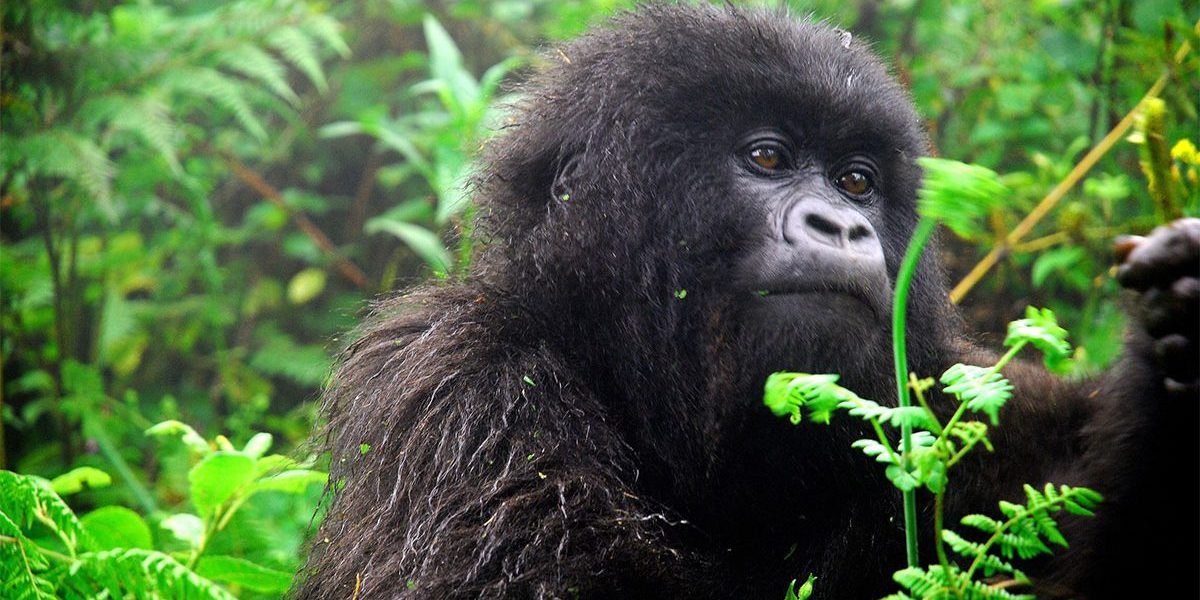
Mubare gorilla family (located in Buhoma)
Ruhondeza lived for over 50 years and continued to be monitored by researchers till his death. His grave is marked and can be located by a guide.
Habinyanja Gorilla Family – Buhoma
This gorilla group is among the very first to be opened to tourists. The group contains 17 members and is led by Makara who replaced Habinyanja. This group was habituated in 1997 and was then led by silverback Mugurisi (old man). The group was named “Habinyanja” (place with water) in Rukiga because they were first sighted near a swamp in Bwindi. After passing away due to old age, Mugurisi was replaced by his two brothers Rwansigazi and Mwirima who had different personality traits. Mwirima liked staying within a specific range while Rwansigazi loved moving around different sections of the forest in 2002 the two brothers separated peacefully. Rwansigazi left with part of the group and retained the Habinyanja name while Mirimas group was named the Rushegura family.
Rushegura Gorilla Family – Buhoma
The Rushegura group contains 19 members including one silverback. This is the group that was formed when Rwansigazi and Mwirima separated from the larger Habinyanja group in 2002. The Rushegura name is derived from “Ebishegura”, a tree specie common within the family’s territory. Mwirima’s ability to create a stable and calm family is admirable as the number of individuals increased from 12 to 19 by April 2010. At about 25 years of age Mwirima is strong and dominant, never shying away from confronting wild groups threatening his authority. Because of the group’s stability and calmness, they are not shy around people and can be seen around lodge gardens.
Bitukura Gorilla Family- Ruhija
The Bitukura family has 14 individuals from its original 24. The group is led by Ndahura who took over from the now-retired Karamuzi. The group that also has three other silverbacks was named after a river near their territory. Whereas the habituation process for mountain gorillas takes 2 or more years, it took only 15 months with this family. Visitors were first allowed in October 2008 but the group had already had frequent encounters with park rangers whenever they mixed with, the already habituated the Kyaguriro family.
Oruzongo Gorilla Family – Ruhija
With 25 members, this is a large group by usual standards. It is the second family in the Ruhija area and includes two silverbacks. Tibirikwata leads the group that first opened to visitors in 2011. The group has grown and is much loved by visitors because of its playful youngsters resulting from several births from the females Ntamurungi (June 2011), Musi (October 2011), and Kakoba (March 2012).
Nkuringo Gorilla Family – Nkuringo
Nkuringo the great silverback initially led this group that now includes 19 individuals. After his death in 2008, he left two silverbacks Rafiki and Safari. Safari, his son took over from him. The group was first spotted near a round hill hence the name “Nkuringo” in Rukiga. Because the group lived near the villages outside the park, they had frequent encounters with humans and often sneaked to eat crops hence having creating conflicts. It was decided to habituate the group in 2008 to allow the community gain from tourism and see the conservation of gorillas as bringing economic opportunities to them.
Nshongi Gorilla Family – Rushaga
At the time the group was opened to visitors and tourists in 2009, the Nshongi family had 37 individuals- the largest ever habituated. It currently has 26 individuals and 4 silverbacks. The family was first seen near a river hence the name Nshongi (referring to the deep honey like color of the river). When it was opened for tourism in September 2009, the family was unique due to its large size. Before they split in 2010, the family lived in harmony despite the many silverbacks. The Nshongi group under the dominant silverback Nshongi remained with 26 individuals while silverback Mishaya moved away with 10 individuals.

Nshongi Gorilla Family – Rushaga
Mishaya Gorilla Family – Rushaga
When Mishaya left Nshongi in 2010, he developed a reputation of starting fights with other gorilla families not only to protect his own, but to also steal females from neighbors. He succeeded in gathering a few females but was wounded in one of the fights with a wild gorilla family (not habituated). Luckily, he was treated by gorilla conservation doctors nearby. The group now has 12 individuals with Mishaya the only dominant silverback.
Kahungye Gorilla Family – Rushaga
This group contains 13 members including 3 silverbacks led by Rumansi. Ruhamuka and Rwigi are the other old males. The group was only recently (2011) opened for visitors. The group had 27 members when habituated but split shortly after creating another group Busingye. The Kahungye group is led by “Gwigi” (door in the local dialect).
Bweza Gorilla Family- Rushaga
This group was opened to visitors in 2012. The group evolves from the Nshongi gorilla family which was the largest family ever habituated in Bwindi. When Silverback Mishaya separated from Nshongi in 2010, Bweza left him two years later (2012) with six members. The group contains 9 individuals still led by Bweza.
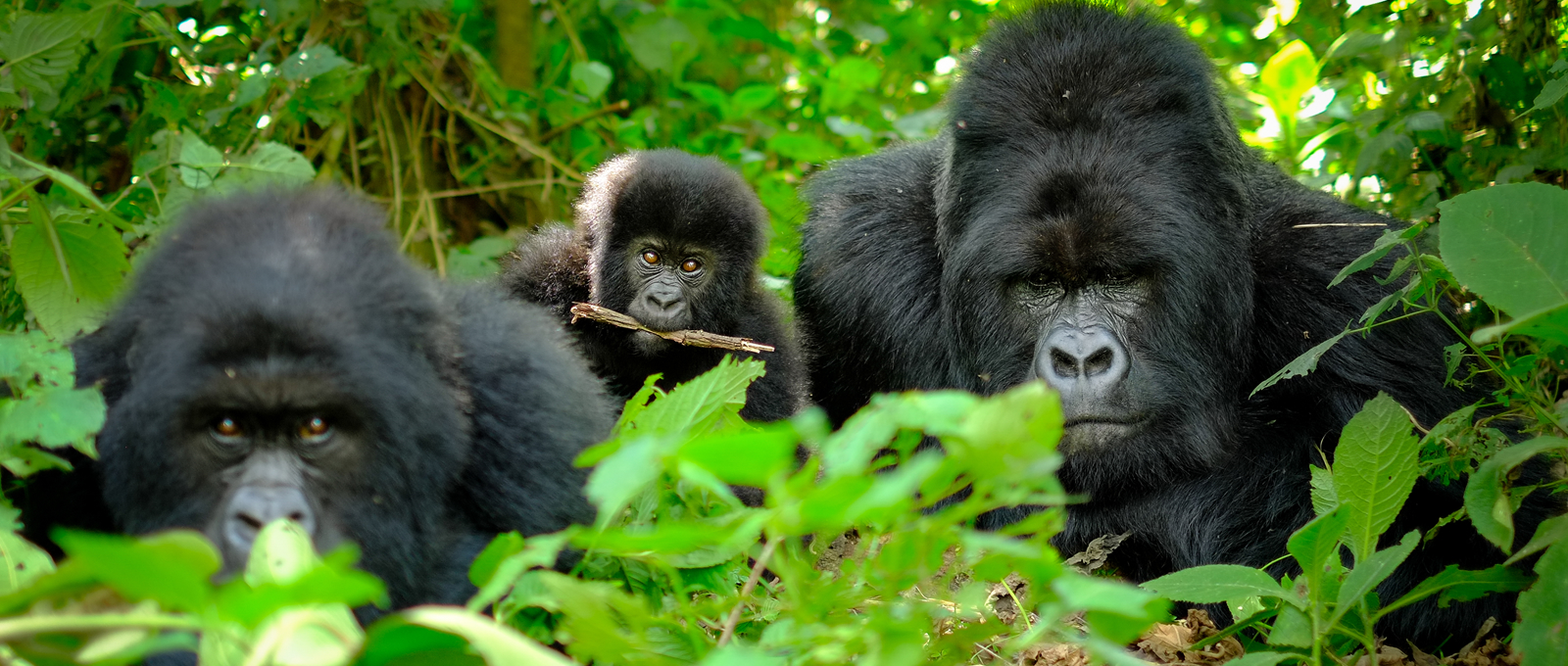
Bweza Gorilla Family- Rushaga
Busingye Gorilla Family – Rushaga
This group was opened to visitors in 2013. Busingye leads this group of 9 members after splitting away from the Kahungye family in 2012. Though his name means peace, Busingye is known for frequent fights and stealing females from neighboring Gorilla groups. He is very ambitious, and dominant and uses every opportunity to show his power.
Kyaguriro Gorilla Family – Ruhija
The Kyaguriro group contains 15 members led by Rukina who grabbed power from the old Zeus. The gorilla group has been set apart for research by conservationists and limited access is given to visitors. Researchers have come up with interesting findings from this group. Their findings show some differences in behavioral tendencies between Uganda’s Gorilla families, Rwanda’s Gorilla families and Congo Gorilla families.
Gorilla Families in Mgahinga National Park
Nyakagezi Gorilla Family – (Mgahinga)
There are only one habituated gorilla group in Mgahinga national park. The group is unpredictable and often migrates to Rwanda and Congo led by mark the dominant silverback. Apart from mark, there are 2 other silverbacks in a group of 10. Because of their unpredictable movements, viewing the family can be difficult. Although they have currently settled in Uganda, you need to contact the authorities through your tour operator to know their exact location.
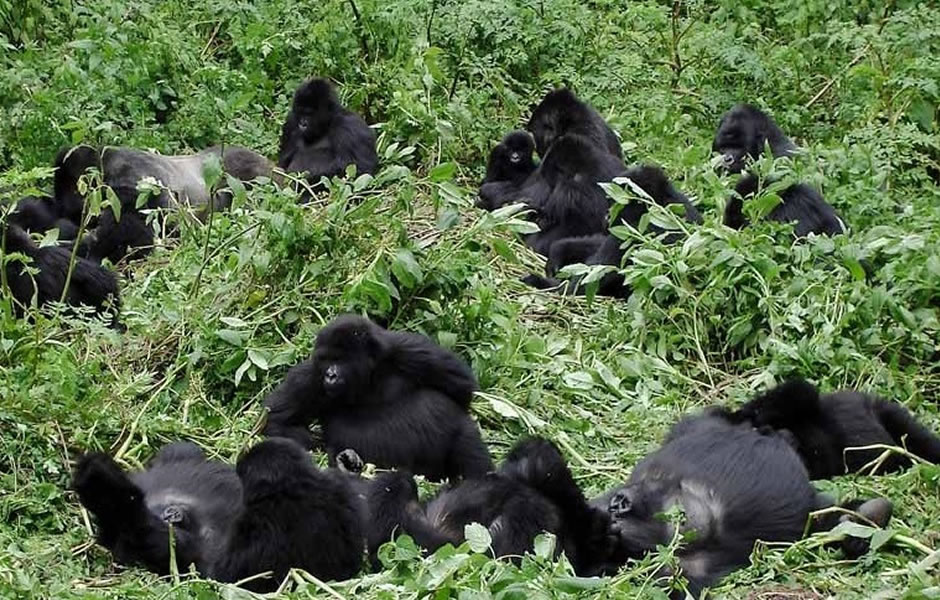
Nyakagezi Gorilla Family – (Mgahinga)
Habituated gorilla families in Rwanda
Volcanoes national park is home of over 360 mountain gorillas. Of these, there are 7 habituated gorilla families that are available for tourists to track. These are the gorilla families you may be assigned during your Rwanda trekking gorilla tour.
Agashya Mountain Gorilla Family.
This family initially had 13 mountain gorilla members and it was then called 13 groups however the mountain gorilla numbers increased and today the family has 25 individual members including a dominant silverback, 12 females, 3 youth gorillas, and 7 young ones.
The dominant silverback Agashya won the leadership crown after overpowering the then group leader Nyakairima in a deadly fight. After winning, Agashya decided to move the gorilla family uphill for protection against any intruders.
Agashya is very ambitious and with his efforts, he managed to increase the mountain gorilla numbers in his family from 12 to 25. Agashya is very protective of his gorilla family and once he senses any danger and intrusion, he moves with the whole mountain gorilla family uphill. This sometimes makes it harder for tourists to trek this gorilla family.
Amahoro Mountain Gorilla Family
With 17 individual mountain gorillas, Amahoro is the most peaceful mountain gorilla family that also lives on a gentle slope. The word Amahoro means peaceful and the dominant silverback (Ubumwe) is indeed very peaceful. Of the 17 mountain gorillas in the Amahoro family, there is one silverback – Ubumwe, 2 black backs (sexually mature male mountain gorillas), 5 young ones, 5 female gorillas, and 4 youth mountain gorillas. Getting to this gorilla group is a little hectic because it also involves hiking however all the tourists who have visited the group always take about their unique experiences and encounters.
Bwenge Mountain Gorilla Family
It mainly comprises of 11 mountain gorilla individuals. The family faced difficult times after the death of 6 young mountain gorillas. This gorilla family lives along the Karisoke volcanic area and it was named Bwenge after the dominant silverback.
Getting to this gorilla family is also a little challenging because it involves a hike of about 2 to 3 hours through the trails and steep slopes.
Hirwa Mountain Gorilla Family
This mountain gorilla family miraculously formed after mountain gorillas from the Sabyinyo family and group 13 (Agashya family) came together to form a joint gorilla family (Hirwa), which means the lucky one.
Lucky indeed it is! The Hirwa gorilla family now has a total of 9 mountain gorilla members including a dominant silverback, 3 female mountain gorillas, 2 juveniles and 3 young ones. The dominant silverback is very strong and determined to protect all the individual mountain gorilla members in the family.
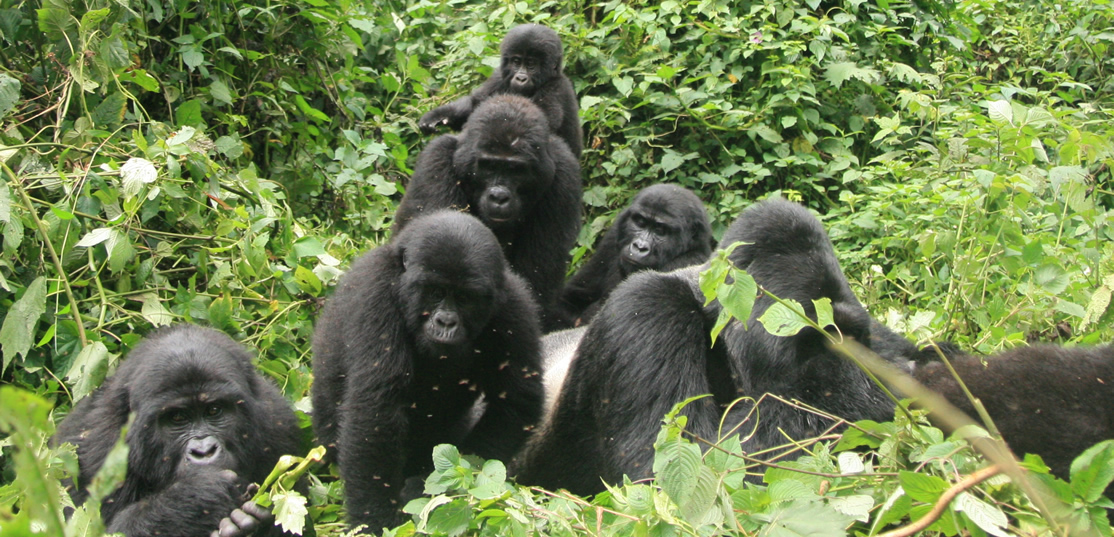
Hirwa Mountain Gorilla Family
Kwitonda Mountain Gorilla Family
This gorilla family shifted from the democratic republic of Congo and it’s made up of 18 mountain gorilla members including Kwitonda the dominant silverback.
It’s among the most difficult gorilla families to trek because most time it keeps far away in thickly forested areas that cannot be easily accessed by tourists. Kwitonda is a Kinyarwanda word that means the humble one that clearly describes the character of the group and the silverback.
Sabyinyo Mountain Gorilla Family
This is made up of 8 mountain gorilla individuals and it inhabits the gentle slopes of the Sabyinyo volcano that Rwanda shares with Uganda. This is among the easily accessed mountain gorilla families in volcanoes national park and it has the biggest silverback (Guhonda) in the whole of the volcanoes national park area.
Being the biggest and obviously stronger, Guhonda is the dominant silverback of the Sabyinyo group and has for a long time managed to keep its major rival silverback Ryango in isolation from the major group. The Sabyinyo gorilla family mainly has 3 female mountain gorillas, 2 youthful gorillas, and a young mountain gorilla.
Susa A Mountain Gorilla Family
This mountain gorilla family lives at a relatively higher altitude and most challenging mountain gorilla group to trek. The family was researched and made famous by Dian Fossey an American zoologist who had taken a long studying the mountain gorillas in Rwanda with her research base at Karisoke.
Initially, with the highest mountain gorilla population – 42 mountain gorilla individuals, the Susa family was reduced to 28 individuals including 3 silverbacks 3 male mountain gorillas).
This mountain gorilla family was named Susa after the river Susa that flows in the proximity of this mountain gorilla family. The Susa gorilla family has some of the oldest habituated mountain gorillas and it’s very famous for its twin mountain gorillas (Impano and Byishimo). Since the Susa family is hard to get to, it can be best trekked by the physically fit and adventurous tourists capable of hiking for a long time. For easy trekking of the mountain gorillas in the Susa family, trackers first go ahead of the tourists to trace where the family is and then direct the tourists accordingly.
Trekking the Susa family is offers exciting moments especially as tourists watch the twin mountain gorillas jump and play around. Other gorilla individuals in the family have been seen either feeding or relaxing around the thickets.
Susa B Mountain Gorilla Family
This is also known as the Karisimbi mountain gorilla family with a total of 15 individual mountain gorillas. This was previously part of the Susa mountain gorilla family but later broke off forming the Susa B or Karisimbi gorilla family.
This gorilla family resides along the slopes of Mount Karisimbi and is also among the difficult mountain gorilla groups to get to. This gorilla family can also be trekked by the physically ale-bodied tourists because sometimes the gorillas move uphill making it hard to get to them by tourists. Trekking this family takes several hours and sometimes a full day.
To make the trekking a little easy, trackers first go to the jungles tracing where the gorillas are and are always able to tell where they (mountain gorillas) would be the next day. If they expect the family to be extremely far, their trekking is stopped.
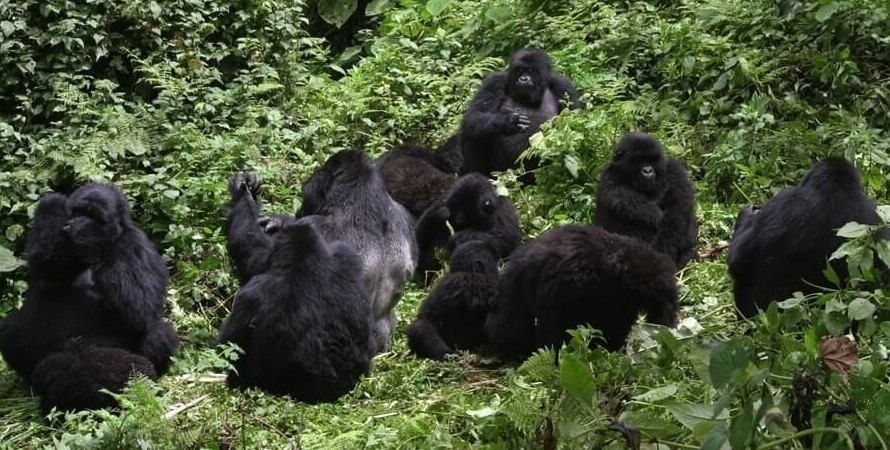
Susa B Mountain Gorilla Family
Ugenda Mountain Gorilla Family
With a total of 11 mountain gorilla members, Ugenda family inhabits the Karisimbi volcanic area and has 2 silverbacks. This mountain gorilla family is also difficult to trek because it always moves from one area to another thus the name Ugenda that explains the family’s characteristics.
Umubano Mountain Gorilla Family
This gorilla family consists of 11 individual mountain gorillas lead by a dominant silverback, 1 black back (sexually mature male), 3 females and 6 young mountain gorillas. This group separated from the Amahoro group after a fight that saw Charles the dominant silverback of Umubano winning Ubumwe (the dominant silverback of the Amahoro group) and leaving the Amahoro group with a number of females.
Rwanda Gorilla Families in Volcanoes National Park
Agashya group
Zoo tours are great but quite boring considering that animals are usually caged and quite domesticated. In contrast, the animals in the parks are totally wild and roam freely. This keeps you guessing as you can’t tell at what point you will be seeing wildlife. This is one of the things that attract tourists to Volcanoes National Park, and to this group in particular. They are adventurous and always on the move to discover the different wonders of the park. As such, the hiking experience to see them is enriched like a treasure hunt as it treats you to many sights and sounds you would have missed out on. It could be natural swimming ponds deep inside the park, some critically endangered bird species, footprints of elephants…. the list goes on.
The group is currently led by a silverback called Agashya who had to overthrow Nyakarima before taking over the throne. The family’s population has grown from 13 to 27 members in a space of 8 years.
Sabyinyo Gorilla Family group
If you wish to encounter gorillas in the wild without going through so much trouble, this group is for you. They like to graze in the easily reachable forest zone of the mountain after which they are named, Mountain Sabinyo. In seasons when food is scarce here, they don’t go very far. Rather, they hang around the lower slopes of the bamboo zone. This preference for less bushy settings makes it easy to take their pictures as they go about their normal wild lives. The group is headed by Guhonda silverback and has 12 members.
Titus Family
It is believed that no other gorilla group had such a special place in the heart of Dian Fossey as the Titus. This is partly because they shared a lot in common. Like her, this gorilla which is comprised of 8 members went through very many low moments and yes, she witnessed so many of them. For instance, she witnessed how its group leader was born amidst excruciating labor pain by his mother. He was called Titus. Fossey was also there when his father, brother, and uncle (Digit) were brutally poached. This horrifying incident left the gorilla’s mother and sister very traumatized. Eventually, they found themselves forced to join other families where they were offered security.
In an effort to repopulate his group with the intention of filling up the emptiness that was brought by the death of his father and uncle, Titus fathered 20 babies with the five females in his group and lots from others. By the time of his death in September 2009 (at the age of 35), Titus had been overthrown by his son, Kuryama, the incumbent King of the Titus Monarchy. The group is based on the eastern slopes of the Karisoke volcano, not so far from the grave of their Godmother, Dian Fossey.
Titus’ uncle, Digit, is the famous gorilla that was featured in the Documentary about Diann Fossey; Gorillas in the Mist. More to that, he is one of the main characters featured in “The Gorilla King” a documentary film by BBC that took 2008 by storm.
Amahoro Gorilla group
Every year, Rwanda organizes Kwita Izina, a global conservation event in which gorillas are named according to their characters. During the second edition in 2005, this group was named Amahoro. It’s a word in the Kinyarwanda language that means someone or something whose peacefulness is profoundly inspiring. Indeed, the 18 members of this group are true ambassadors of peace. They are very tolerant of tourists and only put up a fight when in fear that they are in danger.
To avoid any trouble with its group leader Ubumwe, don’t look directly in his eyes. Like most silverbacks, it makes him feel like you want to challenge his authority. The last gorilla that did this got a beating of a lifetime. He is called Umubano.
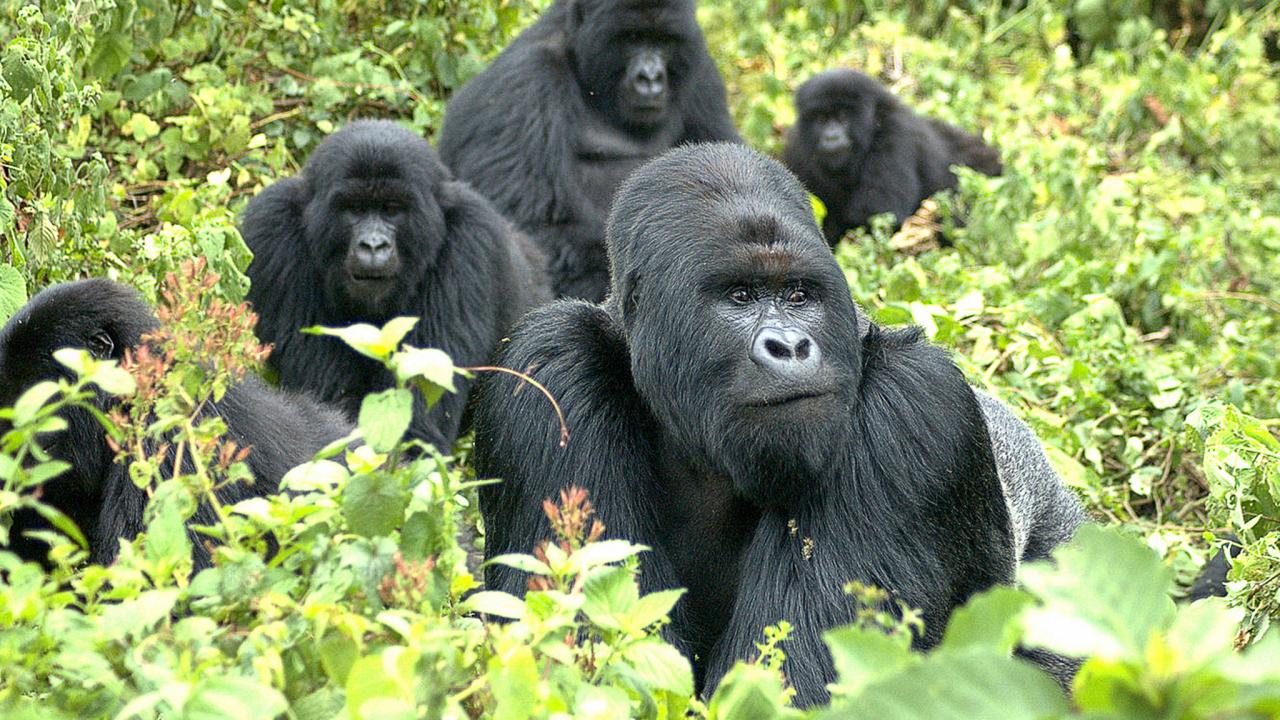
Amahoro Gorilla group
The Amahoro group comprises 2 black backs, 5 infant gorillas, 4 juveniles, 2 silverbacks, and four adult mothers.
Susa A Group
Not every good thing that happens once in a lifetime is welcomed. In mountain gorillas, the birth of twins isn’t that exciting to the mother because it means entering into a stressful phase of caregiving. In this regard, when a mountain gorilla gives birth to twins, it usually abandons one of the infants. Ironically, a mother in this group of 33 members did otherwise. She has defied odds to mother both of her cheerful twins; Impano and Byishimo.
This is one of the things that makes this group one in a million. 10 years ago, the group had one of the biggest populations in Volcanoes National Park, boasting 42 members. 9 of its defiant members split off to form Susa B group, also known as the Karisimbi group.
Umubano group
This group has 13 individuals; one silverback, a blackback, six infants, and three adult females. It was formed by Charles, a dominant silverback who was tired of unending fights in the Amahoro group. This followed lots of invasions by rival gorillas. Accordingly, Charles persuaded twelve like-minded gorillas to join him in forming a family that believes in other ways of solving problems apart from violence. That’s how the group came to be called Umubano, a word in the Kinyarwanda language that means living together in harmony.
Susa B-also is known as the Karisimbi group
Since their split from the Susa A group in 2008, this groups population has grown from 9 to 15. This is thanks to multiple births they have registered. They live in the higher ranges of Mountain Karisimbi-Rwanda’s highest mountain (4,507M). This is one of the things that makes visiting them more rewarding than most gorilla groups. It entails rising towards the highest point in Rwanda from where you can take in views of thousands of majestic hills.
Hirwa Gorilla Family
There are two reasons for which this group is named after a Kinyarwanda word that means lucky. For starters, it is one of the only 7 groups in the Virunga region that has twins. This is a big deal considering gorillas depend on big numbers for protection.
The other reason is that no matter the time of the year you visit it, you have a great probability of finding all its 16 members. They have strong solidarity and always stick together even in the heat of anger. Their preferred location is mountain Sabinyo where they have been roaming freely since their break off from Sabyinyo group and Agashya group some years back.
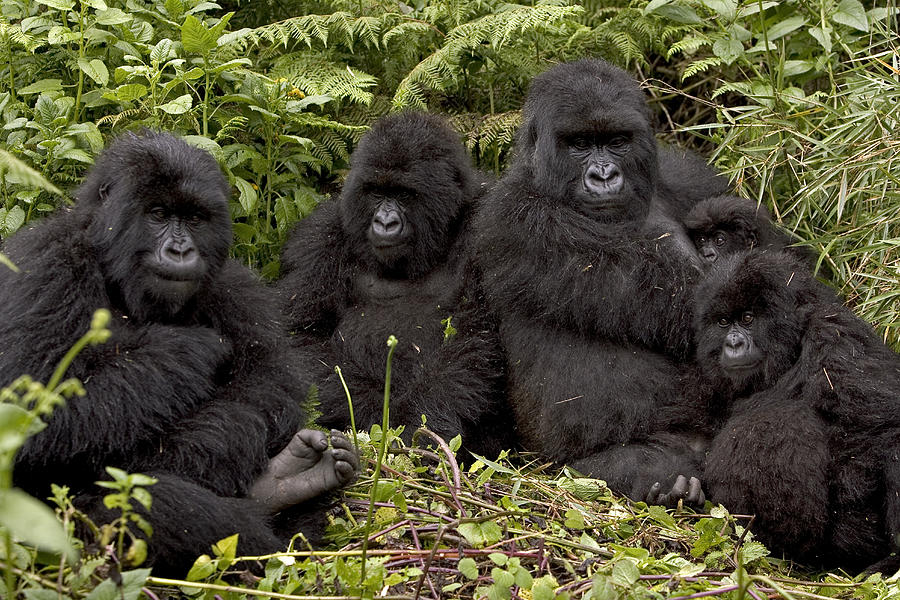
Hirwa Gorilla Family
Kwitonda group
The group comprises of 23 individuals led by Akarevuro, one of the three dominant silverbacks, the other two are Magumu and Kigoma.
Before migrating and settling in the lower slopes of Mt. Sabyinyo and Mt. Gahinga in 2003, the group used to live in Africa’s oldest National Park, Virunga National Park. Then, it was still led by Kwitonda, an adorable silverback that passed on shortly after clocking 40 years in 2012.
The group is named after Kwitonda as he led his family away from the war-torn zones of Congo. As you walk past community land into the park to see this group, kids will cheerfully wave at you while exclaiming “Abba Mzungo”. It means welcome home white friend.0
Bwenge group
After being overthrown from heading the Titus group, Titus formed Beets my group in 2007. For over 5 years, he ruled iron fist and fathered over 20 babies from both within his group and others. One of these babies was Bwenge, an ambitious son who upon clocking 19 years led a revolution that led to the formation of this group.
He was followed by two females from his former group and females from Pablo’s group. Together, they helped him a lay a strong foundation for a small kingdom that now boasts of 11 members. They live in the slopes of Mountain Karisoke. The group has so far lost 6 infants, most of whom were victims of fights with other groups.
Ugenda group
Like identical twins, the 27 gorillas in this group have a very striking resemblance. When you look at their major body features from head to toe, you will spend the next one hour trying to tell them apart but without much luck. You will be amazed by the perfection with which God created them. Astonishingly, the ranger guides can tell them apart without necessarily seeing them, but by hearing the tone of their vocalizations and rate of heartbeat per minute. This follows a connection they developed with them since the time of their habituation few years back. Using this prior exposure, they will identify for you the different individuals and share with you their captivating life stories, highlighting their best and worst moments. Ugenda is made of 11 members including 2 silverbacks.
Leave A Comment